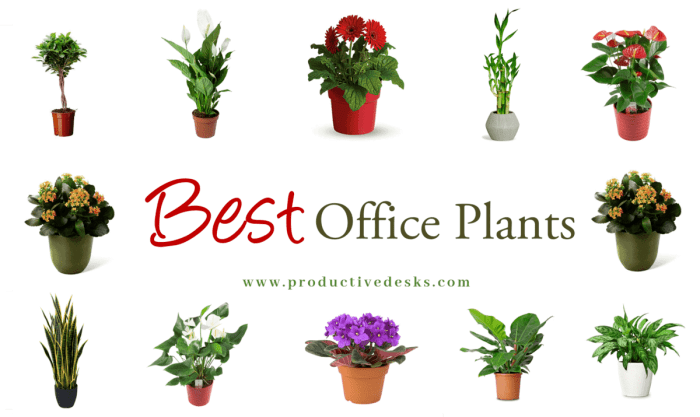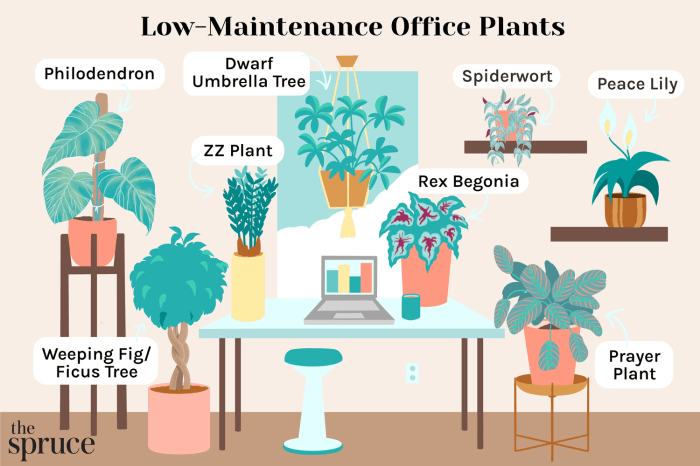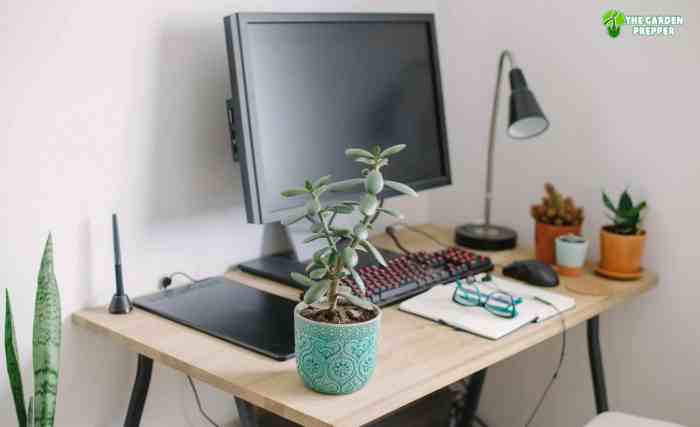For those seeking to spruce up their windowless office desks, best plants for office desk with no windows offer a myriad of benefits, from purifying the air to boosting mood and productivity. Discover the top choices for low-light environments, air purification, and easy maintenance, transforming your workspace into a vibrant and thriving ecosystem.
In this comprehensive guide, we delve into the specific adaptations that enable certain plants to flourish in low-light conditions, explore the air-purifying capabilities of others, and highlight the importance of low-maintenance varieties for busy office environments. We also discuss the aesthetic appeal of plants, providing a range of options to enhance the visual appeal of your desk, and explore plants with specific benefits beyond aesthetics, such as stress reduction and improved focus.
Plants Tolerant to Low Light: Best Plants For Office Desk With No Windows
Plants that thrive in low-light conditions have evolved specific adaptations to maximize their photosynthesis and survival. These adaptations include larger leaves to capture more light, increased chlorophyll content to enhance light absorption, and reduced water loss through smaller stomata to conserve moisture.
If you’re looking for the best plants for your office desk with no windows, you’ll want to choose plants that are low-maintenance and can tolerate low light conditions. Some good options include snake plants, ZZ plants, and pothos. If you’re interested in growing your own food, you might also consider growing herbs or vegetables using hydroponics.
Hydroponics is a method of growing plants in water, without soil, and it can be a great way to grow fresh produce in a small space. Once you’ve chosen your plants, be sure to give them the right amount of light, water, and nutrients, and they’ll thrive in your office environment.
Popular Low-Light Office Desk Plants
- Snake Plant (Sansevieria trifasciata): Known for its upright, sword-like leaves with variegated patterns, it is highly tolerant of neglect and infrequent watering.
- ZZ Plant (Zamioculcas zamiifolia): A hardy plant with glossy, dark green leaves, it can withstand extreme low light and extended periods without water.
- Pothos (Epipremnum aureum): A trailing vine with heart-shaped leaves, it is a versatile plant that can tolerate low light and infrequent watering.
- Peace Lily (Spathiphyllum wallisii): An elegant plant with large, glossy leaves and white, sail-like flowers, it prefers low to medium light and moist soil.
- Spider Plant (Chlorophytum comosum): A graceful plant with long, arching leaves and white or yellow stripes, it is easy to care for and produces plantlets.
Air-Purifying Plants

Indoor air quality in offices can be compromised by various pollutants, including volatile organic compounds (VOCs), dust, and allergens. Air-purifying plants offer a natural solution to improve air quality and enhance the overall well-being of employees.
Even if your office desk lacks natural light, you can still brighten it up with greenery. Snake plants and ZZ plants are low-maintenance options that thrive in low-light conditions. If you’re looking for something a little more vibrant, consider a peace lily or a maidenhair fern.
These plants can also tolerate shady conditions, making them ideal for both indoor and outdoor spaces.
Certain plants possess the ability to absorb and break down these pollutants, releasing clean air into the environment. These plants not only beautify the workspace but also contribute to a healthier and more productive atmosphere.
Common Air-Purifying Plants
- Snake Plant (Sansevieria trifasciata):This hardy plant is known for its ability to remove formaldehyde, benzene, and trichloroethylene from the air.
- Peace Lily (Spathiphyllum wallisii):Peace lilies are effective at removing ammonia, formaldehyde, and benzene. They also help to increase humidity levels, which can be beneficial in dry office environments.
- Spider Plant (Chlorophytum comosum):Spider plants are known for their ability to remove carbon monoxide and formaldehyde from the air. They are also easy to care for and produce plantlets that can be propagated to create more plants.
- Golden Pothos (Epipremnum aureum):Golden pothos is a fast-growing vine that can help to remove formaldehyde, benzene, and trichloroethylene from the air. It is also known for its ability to reduce stress and anxiety.
- ZZ Plant (Zamioculcas zamiifolia):ZZ plants are known for their tolerance to low light conditions and their ability to remove benzene, formaldehyde, and trichloroethylene from the air. They are also very easy to care for, making them a great choice for busy offices.
Low-Maintenance Plants

In busy office environments, low-maintenance plants are essential for maintaining a vibrant and healthy workspace without adding to the workload. These hardy plants require minimal care and attention, making them ideal for those with limited time or experience in plant care.
Here’s a list of easy-to-care-for plants that are suitable for office desks with no windows:
Watering Requirements
- Snake Plant:Water every 2-4 weeks, allowing the soil to dry out completely between waterings.
- ZZ Plant:Water every 3-4 weeks, or even less frequently during winter months.
- Peace Lily:Water when the top inch of soil feels dry to the touch.
Light Requirements
- Snake Plant:Tolerates low light conditions but prefers bright, indirect light.
- ZZ Plant:Can survive in very low light conditions, making it ideal for windowless offices.
- Peace Lily:Prefers bright, indirect light but can tolerate low light conditions.
Aesthetically Pleasing Plants

The addition of plants to an office desk can have a significant impact on the overall decor, bringing a touch of nature and creating a more inviting and aesthetically pleasing environment. Certain plants offer a range of textures, colors, and shapes that can enhance the visual appeal of any workspace.
When selecting plants for an office desk, consider the following:
Variety of Textures
- Snake Plant:Known for its long, upright leaves with variegated patterns, adding a touch of verticality and texture to the desk.
- ZZ Plant:Features glossy, oval-shaped leaves that resemble stacked coins, providing a unique and interesting texture.
- String of Pearls:A trailing plant with delicate, bead-like leaves that cascade over the edges of the desk, creating a soft and flowing texture.
Vibrant Colors
- Chinese Evergreen:Available in a variety of leaf colors, including deep green, variegated, and even burgundy, adding a pop of color to the desk.
- Pothos:A popular choice with heart-shaped leaves that come in shades of green, yellow, and white, providing a touch of brightness and cheerfulness.
- Calathea:Known for its stunning foliage with intricate patterns and vibrant colors, making it a visually striking addition to any desk.
Interesting Shapes
- Spider Plant:Features long, arching leaves with variegated patterns and produces plantlets that resemble baby spiders, adding a whimsical touch to the desk.
- Peperomia:A compact plant with a variety of leaf shapes, including round, oval, and even heart-shaped, providing visual interest and texture.
- Air Plant:A unique and eye-catching plant that doesn’t require soil and can be displayed in a variety of ways, adding a touch of modernity and sophistication to the desk.
Plants with Specific Benefits
Beyond their aesthetic appeal, certain plants offer specific benefits that can enhance the office environment. These benefits include stress reduction, improved focus, and increased productivity.
Scientific evidence supports the positive effects of plants on human well-being. Studies have shown that exposure to plants can lower blood pressure, reduce stress hormones, and improve mood.
For office desks with no windows, low-light tolerant plants such as snake plants, ZZ plants, and pothos are ideal choices. However, if you’re looking to add a touch of greenery and vertical interest, consider incorporating hanging plants. Best plants in hanging baskets include spider plants, ferns, and philodendrons, which thrive in indirect light and add a touch of elegance to any workspace.
When selecting plants for your office desk with no windows, opt for those that require minimal light and can tolerate dry conditions.
Stress Reduction
- Snake Plant (Sansevieria trifasciata):This low-maintenance plant is known for its air-purifying abilities and its ability to reduce stress levels.
- Lavender (Lavandula angustifolia):The scent of lavender has been shown to promote relaxation and reduce anxiety.
Improved Focus, Best plants for office desk with no windows
- Rosemary (Rosmarinus officinalis):Studies have shown that the aroma of rosemary can improve memory and focus.
- Basil (Ocimum basilicum):The scent of basil has been found to enhance alertness and cognitive function.
Increased Productivity
- Peace Lily (Spathiphyllum wallisii):This plant is known for its ability to remove toxins from the air, which can lead to improved indoor air quality and increased productivity.
- Golden Pothos (Epipremnum aureum):This fast-growing vine is known for its ability to purify the air and reduce noise levels, creating a more conducive environment for work.
Final Wrap-Up

Whether you’re looking to create a more inviting and productive workspace or simply add a touch of greenery to your desk, our curated selection of best plants for office desk with no windows provides a solution for every need. Embrace the power of nature and transform your windowless office into a thriving oasis that supports your well-being and enhances your work environment.
Questions and Answers
What are the benefits of having plants on my office desk?
Plants can improve air quality, reduce stress, and boost productivity.
How do I choose the right plants for my office desk?
Consider the amount of light your desk receives, the size of your desk, and your personal preferences.
How often should I water my office plants?
Most office plants need to be watered once or twice a week.